Hello and welcome to ‘Focused on Feld’. In this series of reviews, I am working my way backwards through Stefan Feld’s entire catalogue. Over the years, I have hunted down and collected every title he has ever put out. Needless to say, I’m a fan of his work. I’m such a fan, in fact, that when I noticed there were no active Stefan Feld fan groups on Facebook, I created one of my own.
Today we’re going to talk about 2009’s Macao, his 9th game.
Now a Chinese city, in the 17th century, Macao was a Portuguese colony and a major trading hub. In the game of Macao, players take on the roles of Portuguese adventurers as they improve the city’s infrastructure, gather precious goods, and then trade those goods all throughout Europe in the quest to be the most prestigious adventurers of their day.
Macao is played over the course of twelve rounds. On the surface, it’s a game with a mixed bag of mechanics: a little bit of tableau building, a sprinkling of pick up and deliver, and a smattering of area control. But what Macao really is, for lack of better terminology, is a turn-building game.
At the beginning of each of the game’s rounds, five differently colored dice are rolled and placed into the center of the playing area. Then players select two of these dice to collect cubes. The color of the cubes they collect are equal to the colors of the selected dice. The amount of cubes collected is determined by the value. But, more importantly, that value also determines how many turns the players will have to wait before they have access to the cubes they’ve collected. After the players have collected their dice, their player components called ‘wind roses’ turn and the cubes in the next area of the wind rose become available to them for that turn.
These cubes are spent to improve the city and collect goods by buying up the city’s quarters, jockeying for turn order position by moving your player marker along the wall, activating cards and paying for their abilities, and moving your ship along the waterways to deliver the goods you’ve collected. In true Stefan Feld fashion, Macao is a game ripe with victory point scoring opportunities and just about everything you can do will result in you earning some at various stages of the game. And the person with the most at the end of the game wins.
There are many other granular details I’ll talk about shortly. This is just a high level overview of the game. If you think you’ve heard enough and just want to know what I think, feel free to skip ahead to the Thoughts section. Otherwise, read on as I give you a run down on how Macao is played.
Anchors Aweigh
Macao is set up thusly:
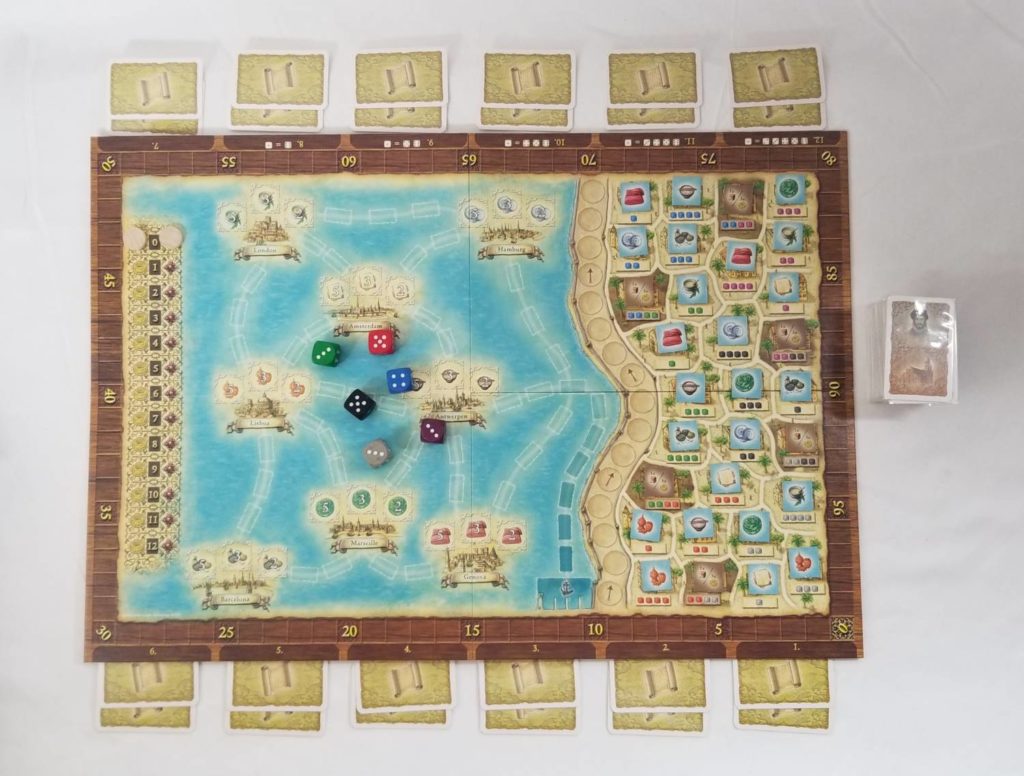
After placing the main board onto the table, the 24 Office cards are shuffled and two are placed, face up, along the outer edges of the board for each round of the game. The remaining cards are shuffled into a deck and placed close by. The Goods tiles are shuffled and one is randomly placed on each of the city’s quarters. The Joker tiles are placed into their labeled positions as well. The beige discs are placed next to the Tribute track. The remaining components—the cubes (which can be sorted if you’d like, but I just keep mine in a large bowl) and the coins—are set aside within easy reach.
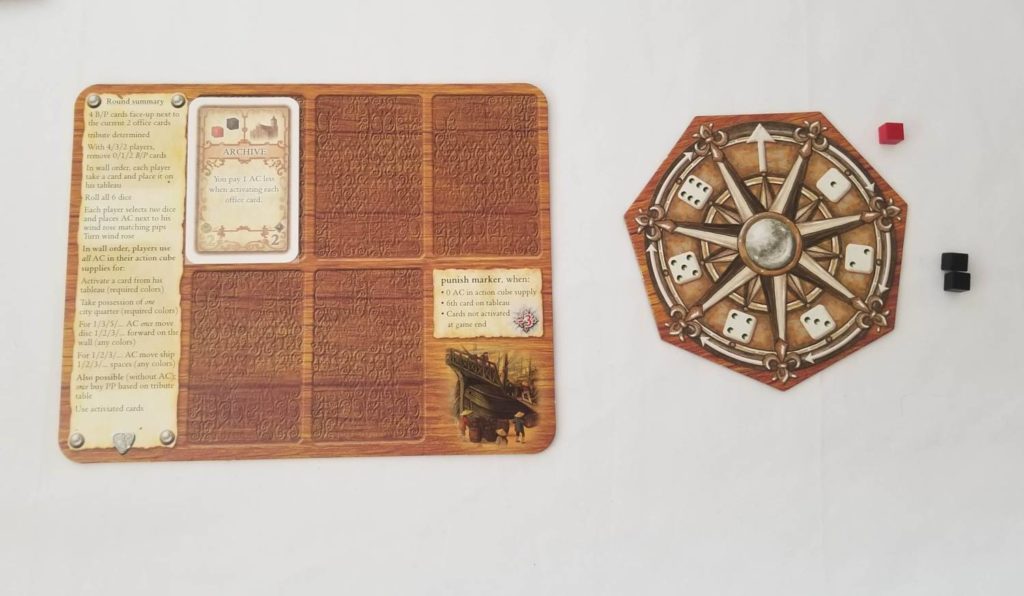
Next, each player chooses a color and receives the pieces of their chosen color which include a wind rose, a ship, two discs, a tableau, and twelve Ownership markers. In addition, they each receive five gold. The player’s discs are placed onto the wall and the Prestige track. Their ship is placed onto one of the slips.
And now that you’ve done that, select a turn order by some means and stack the players’ wall discs in the selected order from the top down. From now on, the player whose disc is furthest along the wall and on top will be the first player for the current round. The second, third, and fourth are determined in the same fashion—furthest ahead and closest to the top of any stacks.
In turn order, each player will be drafting a card from a small selection of cards. This card is placed into their tableau. Each player also receives a single cube of their choice to place next to the one pip area of their wind rose and two cubes, whose colors match one another, to place next to the two pip area. Now, you’re ready to play Macao.
Cubism
In Macao, you live and die by your wind rose. As such, before I delve into the game play any further, it’s important to understand how the wind rose works.
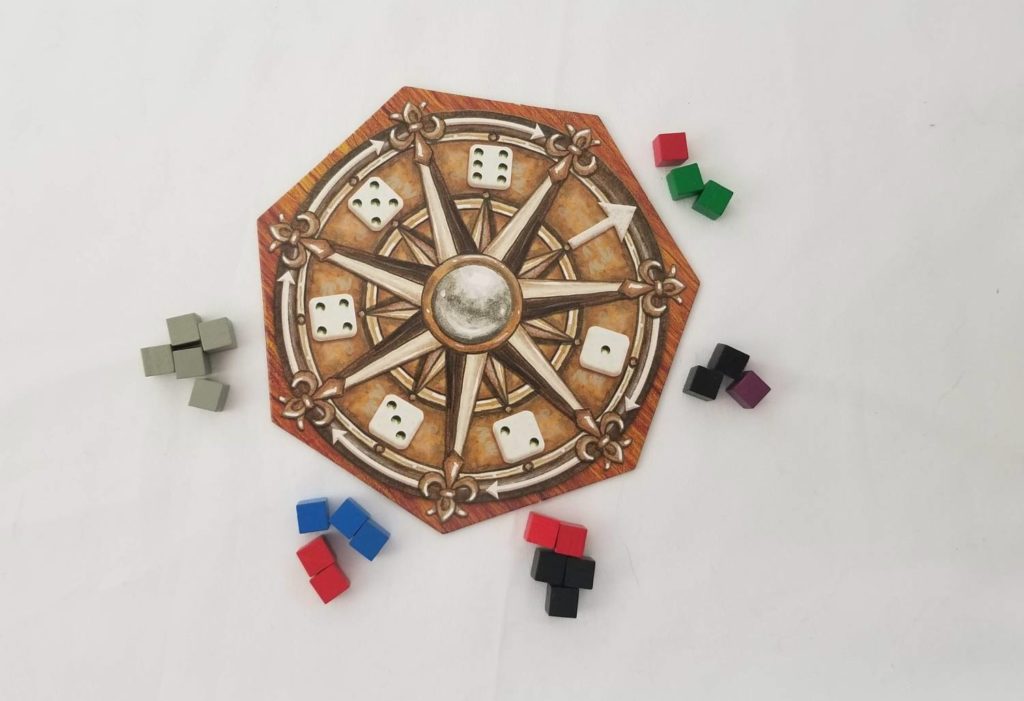
Your wind rose is divided into seven sections. Six of these feature an image of a die set to a different pip value (from one to six) and the seventh features the image of a large arrow. As cubes are collected, they are placed into an area next to the wind rose adjacent to the value of the die that was used to collect them.
To better illustrate this, consider the following example: as their dice, the player selects a red three and a blue four. They take three red cubes from the supply and then place these adjacent to the wind rose area depicting the die with three pips on it. Four blue cubes are placed next to the four pip die face.
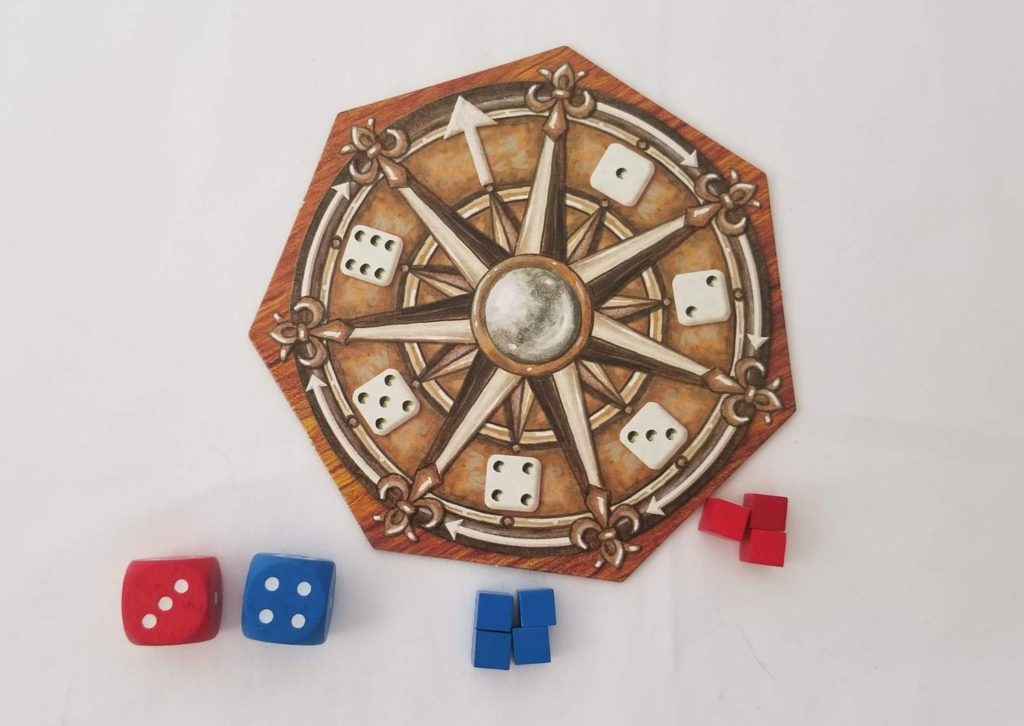
After selecting their dice and collecting their cubes, each player rotates their wind rose. The arrow will then be pointing at the cubes available to the player for the current round. If there are no cubes, the player takes a penalty marker and this will cost them three points at the end of the game.
So, choosing higher value dice will set you up with a lot of cubes in future rounds, but you can’t outright ignore the lesser valued rounds entirely without the risk of taking on penalties. This is the life blood of Macao. But, as important as it is, there are still plenty of other considerations.
Other Considerations
Before rolling the dice at the start of a round, there is a card phase. In this phase, four cards are drawn from the deck and added to the two cards set aside during setup for the current round. These cards feature a tribute value in the bottom right corner and a coin value at the bottom left. These values are totaled up and the beige discs of the Tribute track on the main board are arranged accordingly.
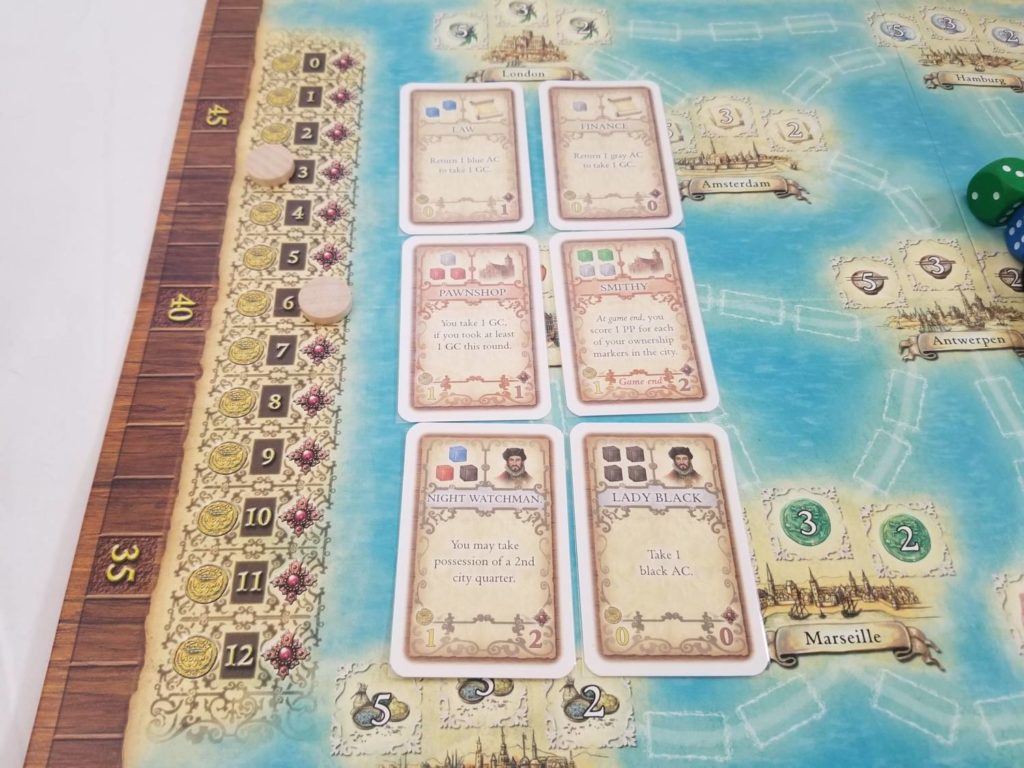
This indicates that, during their turn, a player can purchase the amount of Prestige on the right by paying an amount of gold equal to the value on the left. This is one consideration, and it’s a risky one. Do you pay the amount being requested now for the reward that’s on offer or do you hang onto your money (and money is very tight in Macao!) in the hopes of an even better deal, which may never materialize, later on?
After the Tribute track is arranged, players take turns, in player order, choosing one of the cards to place into their tableau. Each card has a cost in cubes required to remove it from the player’s tableau to their active card area. Each player’s tableau can only accommodate five cards. If the tableau is already filled when the player selects a card to place into it, one of the cards in the tableau is discarded to make room for the new card and the player collects a penalty token which, you guessed it, is worth negative three points at the end of the game. This is another consideration. The harder to play cards typically feature stronger abilities. How many of these do you want to take on?
Once the card phase is complete, the dice are rolled, cubes are collected, and the wind roses turn (possibly resulting in penalty tokens)—as described previously. Then the action phase begins. During their turns, players may expend cubes to:
– move their marker along the wall to jockey for turn order.
– buy a single city quarter by paying the cost and replacing the goods tile that sits atop it with one of their Ownership markers.
– move their ship one space along the waterways one space per cube spent. If a player lands their ship at a port for which they possess the matching good(s), they deliver it/them to the port (starting with the highest valued space) and collect the Prestige for doing so.
– activate any cards that have been removed from their tableau to their active cards area and for which they have the requisite cubes to do so. Typically these kinds of cards will reward Prestige or coin in exchange for specific cubes.
Sometimes you only have very few cubes at your disposal. In these instances choosing what to do with them is pretty easy as there aren’t many options available to you. But there will be plenty of times where these decisions are not easy.
To better understand why these decisions might be tough, let’s talk about scoring.
The Prestige
Prestige comes at you from many different angles in Macao. Some of it you’ll earn during the course of the game from various cards you may have activated, goods you’ve delivered, or the Tribute track. A large percentage of it, though, will come from end game scoring.
At the end of the game, you’re going to earn points for your largest cluster of Ownership markers in the city—two points for each in the cluster—and you’re going to take a penalty token for each card left over in your tableau. Additionally, there are many cards that, once activated, will earn you end game points as well.
The person with the most Prestige wins and ties are broken by whomever is furthest along on the wall.
Thoughts
As I sit here ruminating about Macao and how it makes me feel, I’ve come to a weird realization. For a game that I love so much, I have a lot of negative things to say about it. For instance:
– Nowhere in the game (the components or the rule book) are the various goods types ever explained. The cards refer to them by their names, but there are no accompanying illustrations to tell you what’s what. Got a card that scores you extra points whenever you deliver lacquerware? Good luck figuring out which good that is. I think it’s the red one that looks like a bunch of vases? Then again, there’s the blue and white ones that resemble delftware. So, maybe it’s those instead? Or maybe it’s the one with the green dinner plate on it. Who knows?
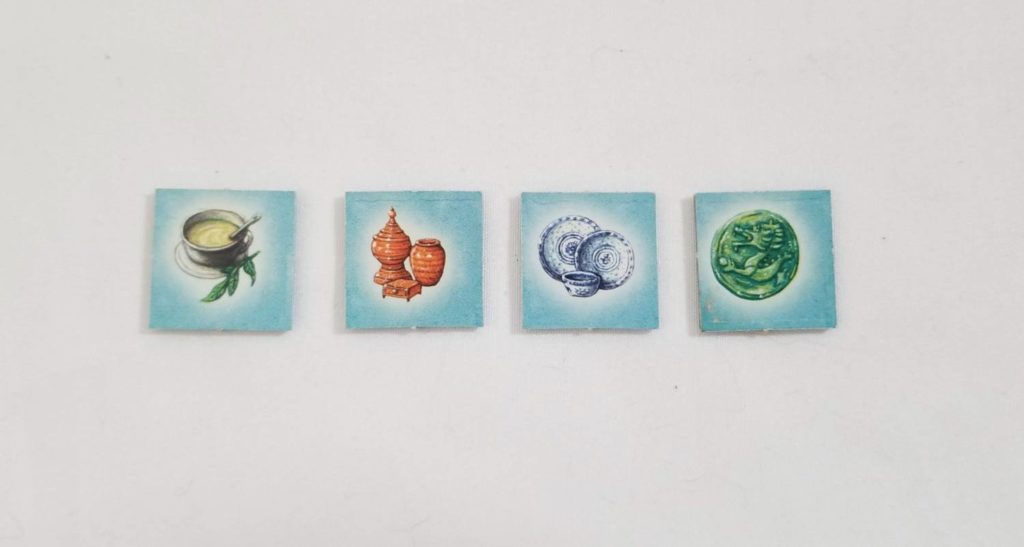
– Macao has some of the cheapest, low quality components I have ever encountered. This isn’t the game’s fault so much as it is the publisher’s. In my experience with older Alea games, this ‘cutting corners craftsmanship’ seems to be the norm rather than the exception.
– The tribute table is so random that some games go by in which nobody takes advantage of it. And that strikes me as odd. In a well balanced game, there should never be an aspect of it that feels irrelevant. Yet, the tribute table often does.
– Other than a few cards that reward their owners for doing so, there is very little impetus to move along the wall other than going first. In fact, most games I play feature very little wall movement. Oftentimes, the only reason anyone moves along the wall is because it’s their only option to spend the single cube they’re holding onto. It’s an afterthought more than an intentional choice.
– Macao is rife with disappointing turns in which you have no cubes and nothing to do. A portion of this is due to poor planning. But a larger portion of it is due to the random nature of the dice rolls coupled with the random nature of the card draws. Hence, going first is important since you’ll get first crack at the lousy cards that fate has dealt you.
– Some of the terminology used in the game is counterintuitive and it often leads to confusion as a result. For instance, consider the idea of a ‘tableau’. In most games, your tableau is the group of cards or tiles that you’ve assembled before you that you’re actively using to do things. Not so in Macao. In Macao, having too many cards in your tableau can hurt you and you’ll want to activate them as soon as possible.
And that word ‘activate’? I’ve got a problem with that, too. When I think ‘activate’, I think ‘use a thing’s ability’. So, when you see a card in the game that fires off whenever you ‘activate’ a certain type of card, you might be tempted to think the card will reward you whenever the specified type of card is used for whatever it’s used for. But you would be wrong. That card only fires off whenever you move the specified type of card from your tableau into your active card area. It’s not nearly as useful as you thought it was!
– The idea of goods you’ve collected from the city magically appearing on your boat in the middle of its voyage presents an unseemly thematic issue. I guess 17th century Portuguese sailors featured teleportation devices on their sailing vessels?
– But my biggest gripe with Macao is with the one thing that really sets it apart from any other game out there: the wind rose. It’s very easy to forget to turn your wind rose, and if it gets jostled, it’s not uncommon for you to forget which round it should be on. There have been many, many games where we’re getting down to the final one or two rounds and one of the players either has too many windrose areas remaining or not enough. This happens so much, in fact, that I designed a crude tool (I am not graphic design expert) to help keep track of it which you can find here: Macao Wind Rose Underlay.
All of that being said, I think Macao is a fantastic game. Whether I am just perceiving design intention as flaws or whether those flaws are unintentional, the end result is the same: each and every game of Macao presents me with a unique and challenging puzzle to overcome. Every decision I am forced to make has me worried that maybe I didn’t make the right one. Every risky move (like praying that a one rolls up on one of the dice so that my one pip area will have something in it so I can avoid taking a penalty) has me on the edge of my seat hoping that my pressing of my luck pays off. When it doesn’t, it never fails to elicit a groan. And there’s no denying the absolute pleasure of entering a turn with twenty or more cubes at your disposal.
It’s these kinds of moments at which Stefan Feld excels. He has a knack for designing games which snowball into some amazing, and memorable, turns. By and large, it’s the feeling of those moments that override everything else. When I’m not actively playing the game, it’s easy to pick at its frayed edges to watch it unravel. But when I’m in the thick of it, I’m not thinking about any of that. I’m just having loads of fun.
I’m glad I stumbled across someone selling it back in 2017 and I’m glad I had the $80 to fork over at the time. Macao quickly became one of my all-time favorite Felds and it remains so to this day. Give it a try and I think you’ll agree. And if you can’t find a copy, don’t fret, it’s free to play on Yucata!


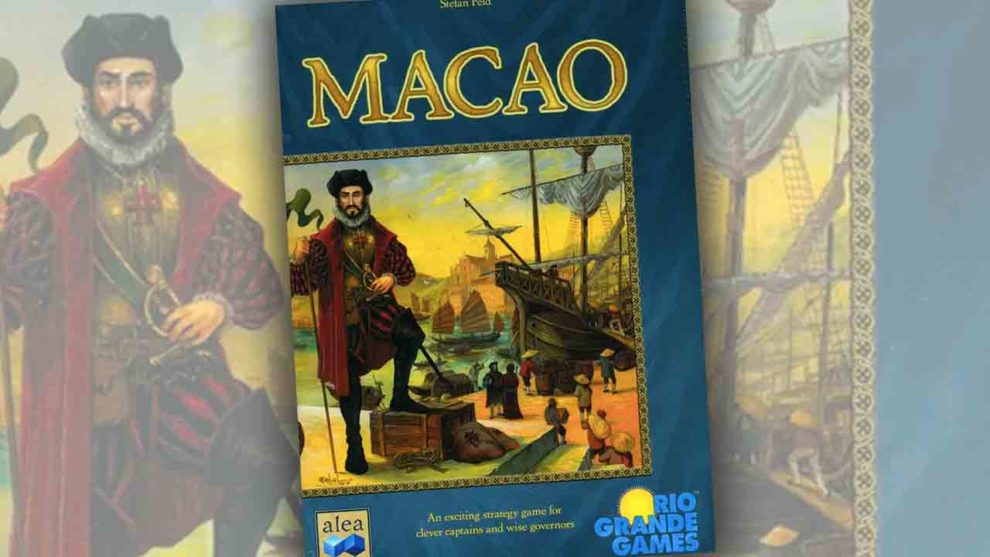









Macao is my favorite game ever! I love it so much. But then I really love tactical games. And BGG has you covered for one of your big complaints which was also one of mine! No more wondering! https://boardgamegeek.com/image/722257/macao
Thanks for taking the time to read my review and respond to it. Macao’s pretty great. I wish the information provided in that link had been included in the game!